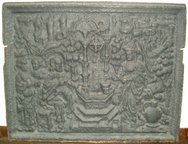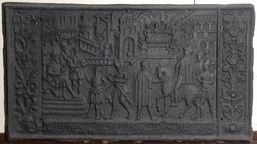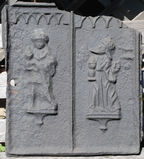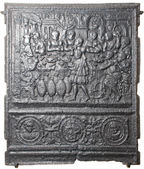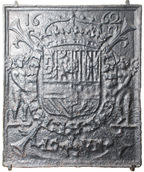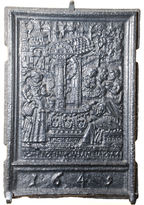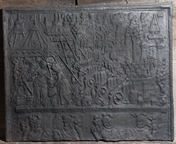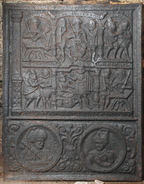-
420
Description: Rectanglular; flanged cavetto-moulded edging; pictorial scene of Christ and the woman of Samaria at Jacob's Well.
Notes: Stoveplate; the scene illustrates the story from John 4.
- Decoration tags:
- rectangular (shape)
- flanged (edging)
- whole carved pattern
- pictorial
- biblical
- humans
Manufactured: in the late-16th to early-17th century possibly in the Eifel area of Germany.
Current location: Anne of Cleves House, Southover High Street, Lewes, East Sussex, England.
Museum number: LH000.797 (part of the Sussex Archaeological Society museum group)
Citation: Dawson, C., 1903, 'Sussex Iron Work and Pottery', Sussex Archaeological Collections, 46, pp. 1-54.
- Attached to series:
- Stoveplates
- Woman of Samaria stoveplates
-
421
Description: Rectangular; flanged edge; central pictorial panel illustrating Mordecai arriving before King Ahasuerus, Haman hanging from the gallows behind; two floral side panels, at the top of each a monogram within a cartouche: on the left KS, on the right H?D.
Notes: Stoveplate; the scene illustrates a scene from Esther 7: 10 and 8: 1. Formerly part of the J. H. Every collection.
Copies of this fireback are known.
Inscription: KS H[?]D
- Decoration tags:
- rectangular (shape)
- flanged (edging)
- whole carved pattern
- pictorial
- biblical
- architectural
- text
- humans
Manufactured: in the late-16th to early-17th century possibly in the Eifel area of Germany.
Current location: Anne of Cleves House, Southover High Street, Lewes, East Sussex, England.
Museum number: 1944.24.040 (part of the Sussex Archaeological Society museum group)
- Attached to series:
- Stoveplates
- Esther stoveplates
-
422
Description: Rectangular with a square projection middle top; castellated top edging; top centre, stylised Calvary; upper section: pictorial scene, centre, house with tiled roof, windows, and chimney at each end, paths leading from house; left, possible forge building with four chimneys and three water wheels, and adjacent furnace stack?; above, shed with lean-to, barrow, and wheel structure, all between trees; right, figure of a man running towards the house, unidentified objects between trees; lower section: plain panel with central triple-grooved horizontal line.
Notes: A striking and unusual fireback with a scene suggesting a connection with iron-making. Formerly part of the J. H. Every collection.
Copies of this fireback are known.
- Decoration tags:
- rectangular with square arch (shape)
- castellated (edging)
- whole carved pattern
- pictorial
- humans
- plants
- objects
Manufactured: in the late-16th to early-17th century possibly in the Eifel area of Germany.
Current location: Anne of Cleves House, Southover High Street, Lewes, East Sussex, England.
Museum number: 1944.24.045 (part of the Sussex Archaeological Society museum group)
- Attached to series:
- Miscellaneous pattern firebacks
-
434
Description: Damaged; rectangle, flanged edging; two vertical panels, each with a row of lancet arches along the top: on right, robed figure with a crown, head tilted to left, left hand raised in benediction, right hand holding a chalice, standing on a bracket; on right, similar figure facing forward.
Notes: Stoveplate. Similar plates suggest these may be two of the Magi.
- Decoration tags:
- rectangular (shape)
- flanged (edging)
- simple stamps
- architectural
- humans
Manufactured: in the early-16th century in the Eifel area of Germany.
Current location: Anne of Cleves House, Southover High Street, Lewes, East Sussex, England.
Museum number: LH000.795 (part of the Sussex Archaeological Society museum group)
Citation: Dawson, C., 1903, 'Sussex Iron Work and Pottery', Sussex Archaeological Collections, 46, pp. 1-54.
- Attached to series:
- Stoveplates
- Figurine firebacks
-
547
Description: Rectangular with flanged edging; upper rectangular panel with cyma recta edging; pictorial scene of the Marriage at Cana; lower rectangular panel with fillet edging; three circular medallions with twin, concentric fillet edges, the left one with the bust of male, the right one with the bust of a female and the centre one with a floral design.
Notes: The scene is from the New Testament - John 2. Mitford collection, Petworth House.
- Decoration tags:
- rectangular (shape)
- flanged (edging)
- whole carved pattern
- planklines
- pictorial
- biblical
- humans
Manufactured: in the late-16th to early-17th century possibly in the Eifel area of Germany.
Current location: Petworth House, Petworth, West Sussex, England.
Museum number: NT/PET/M/103 (part of the National Trust museum group)
- Attached to series:
- Stoveplates
- Marriage at Cana stoveplates
-
524
Description: Rectangular; cavetto-moulded edging; shield, crown and supporters of King Philip IV of Spain, incorporating the arms of Castille and Leon, Aragon - Sicily, Granada, Portugal, Austria, Burgundy and Brabant; around the shield is the chain of the Order of the Golden Fleece; at the top, the date split by the crown; behind, crossed lilies.
Notes: By 1662 the arms of Portugal were redundant on the Spanish royal arms, but were retained until after the death of Philip IV; the word, LOVEN, indicates the particular association of this plate with the town of Leuven, the capital of Brabant in what was, at the time, part of the Spanish Netherlands. Mitford collection, Petworth House.
Inscription: 16 62 / LO VEN
Arms: King Philip IV of Spain
- Decoration tags:
- rectangular (shape)
- double fillet (edging)
- whole carved pattern
- individual numbers
- armorial
- royal
- text
Manufactured: in 1662 possibly in the Eifel area of Germany.
Current location: Petworth House, Petworth, West Sussex, England.
Museum number: NT/PET/M/78 (part of the National Trust museum group)
- Attached to series:
- Foreign armorial firebacks
-
529
Description: Rectangular with three arches, the middle one larger than the outer two; cavetto-moulded edging; bottom panel, pictorial scene of Jesus and the woman of Samaria at the well (John 4), with other figures, buildings etc. in the background, illegible text below; centre arch, shield, helm, crest and mantling of unidentified arms, the initials 'GP' in bottom corners; left arch, probable figure of a saint; right arch, probable figure of a soldier. Mitford collection, Petworth House.
Notes: The combination of a biblical scene (John 4) with a coat of arms.
Inscription: 16 30 / G P
- Decoration tags:
- rectangular with three arches (shape)
- cavetto (edging)
- whole carved pattern
- pictorial
- biblical
- armorial
- text
- humans
Manufactured: in 1630 possibly in the Eifel area of Germany.
Current location: Petworth House, Petworth, West Sussex, England.
Museum number: NT/PET/M/83 (part of the National Trust museum group)
- Attached to series:
- New Testament firebacks
- Foreign armorial firebacks
-
550
Description: Rectangular; flanged edging; rectangular upper panel with cyma recta edging; pictorial scene of Jesus sitting at the well with the woman of Samaria, inscription along the bottom edge; lower inset rectangular panel with date in relief.
Notes: The inscription reads: From the maiden of Samaria - John 4. Mitford collection, Petworth House.
Inscription: VOM FROWLEIN VON SAMARIA JOH 4 / 1649
- Decoration tags:
- rectangular (shape)
- flanged (edging)
- whole carved pattern
- pictorial
- biblical
- text
Manufactured: in 1649 possibly in the Eifel area of Germany.
Current location: Petworth House, Petworth, West Sussex, England.
Museum number: NT/PET/M/92 (part of the National Trust museum group)
- Attached to series:
- Stoveplates
- Woman of Samaria stoveplates
-
703
Description: Rectangular; cavetto moulded edging; pictorial scene of the siege of Bethulia, with Judith placing the severed head of Holofernes into the bag held by her maid; in the lower panel are the top parts of four knightly figures.
Notes: The design is after one by the pattern-maker, Philipp Soldan, and derived from a woodcut of an engraving by Israhel van Meckenhem; it illustrates scenes from the Apocryphal book of Judith.
- Decoration tags:
- rectangular (shape)
- cavetto (edging)
- whole carved pattern
- pictorial
- biblical
- humans
Manufactured: in the late-16th century in the Eifel area of Germany.
Current location: Tiverton Castle, Tiverton, Devon, England.
- Attached to series:
- Stoveplates
-
705
Description: Stove side plate; cavetto moulded edging; upper panel, Ionic column and pedestal to left; six courtly scenes separated by arches and columns; lower panel, two circular frames, each with a figure, male to the left, female to the right, decorative scroll work between.
Notes: Possibly a graphic retelling of the parable of the Unjust Steward (Luke 16: 1-13)
Inscription: [illegible]
- Decoration tags:
- rectangular (shape)
- flanged (edging)
- whole carved pattern
- pictorial
- biblical
- text
- humans
Manufactured: in the late-16th to early-17th century possibly in the Eifel area of Germany.
Current location: Tiverton Castle, Tiverton, Devon, England.
- Attached to series:
- Stoveplates
